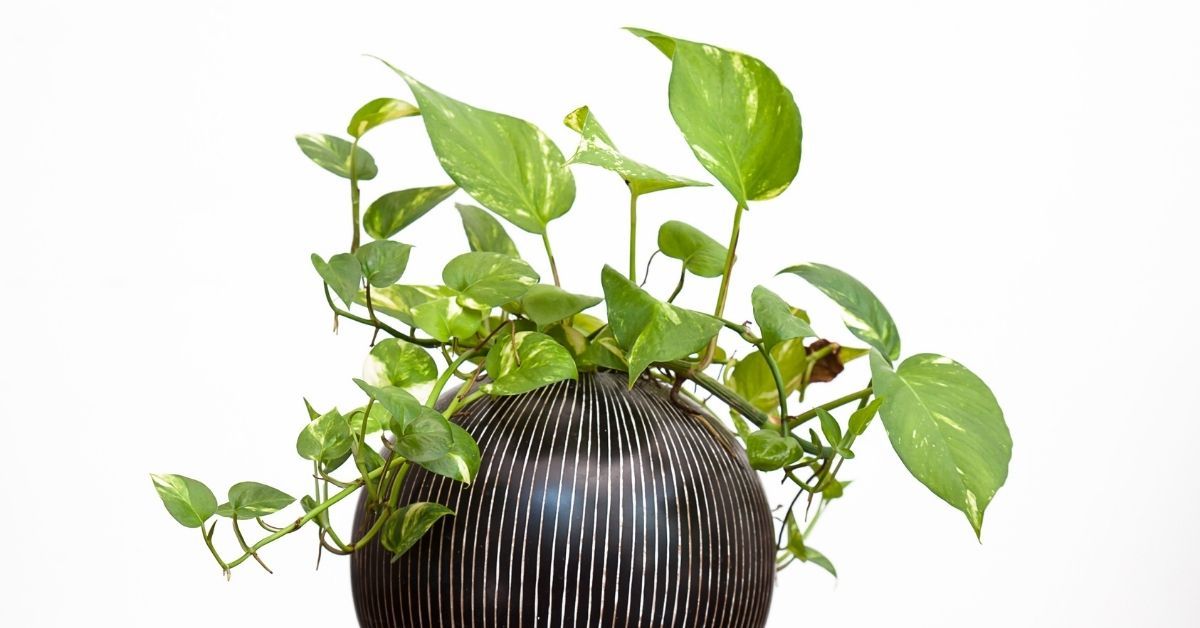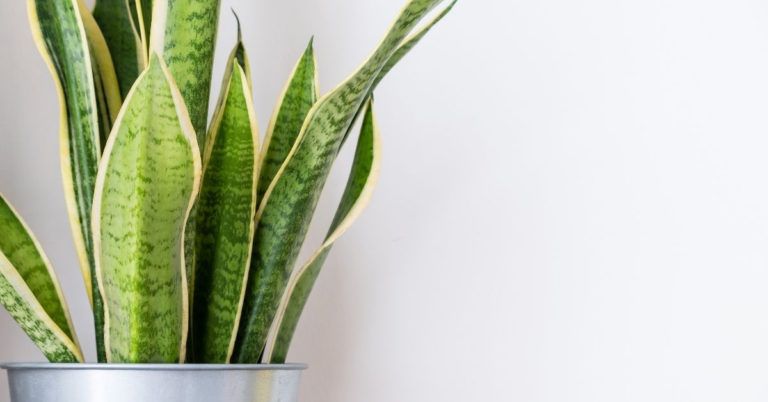Beginner Golden Pothos Care: How to Care for a Golden Pothos

Golden pothos is a great indoor plant to have around your home. They are easy to grow, relatively inexpensive, and require little maintenance.
This is our golden pothos care guide for beginners to get you started caring for your golden pothos.
As with any plant, caring for pothos can be a little tricky. But, like many houseplants, a little attention will go a long way.
If you’re looking for a low maintenance plant, the golden pothos is a perfect choice.
In fact, this low-maintenance indoor plant has been called “one of the best beginner plants.”
In this guide, we’ll cover everything you need to know about growing and caring for golden pothos. You will learn about:
- How to care for a golden pothos
- Common golden pothos problems
- How to propagate a golden pothos
- and more…
Let’s dive right in!
About the Golden Pothos

Golden pothos is a very popular houseplant native to Southeast Asia and the Pacific.
The heart-shaped green leaves with yellow variegation are the distinguishing features of golden pothos.
With a bright green, leafy rosette, an eye-catching golden center, and a tall, stilt-like stalk, the Golden Pothos is a beautiful addition to any houseplant collection.
It does, however, have certain variations with deeper green leaves, white spots, and more vibrant leaves.
The golden pothos is also known as the Japanese Spider Fern or Devil’s Ivy.
The huge, leafy plant itself has its own reputation due to its forest origin. The shrub plant grows on the floor and the tree trunks in the forest area.
It also has an aerial root system that helps it grow even in a vertical position.
How to Care for a Golden Pothos
As long as you provide the basic needs, it is relatively easy to care for and love your golden pothos.
In fact, golden pothos is one of the best houseplants for beginners you can get out there.
A little bit of sunlight, well-drained soil, and regular water is all that is required for this indoor houseplant.
But just like any other houseplant, proper care will go a long way toward extending the life of your golden pothos.
Keep reading to learn how to give your golden pothos the best care possible!
Light
Light is essential for your pothos. If you plan on having the golden pothos as a houseplant, the best place for it is indoors.
So, while it is good to place your pothos in indirect sunlight, it is also vital to put them in a shaded area.
This is so the plant does not overheat or experience too much light.
Indirect sunlight is best, with the rays filtering through a window or under a light source.
In most cases, your golden pothos will grow best in an average-light environment.
It is a low maintenance plant, so it does not require a lot of light. It only needs enough light to grow and flourish.
Water
Golden pothos does not need too much water to live when it comes to watering.
In fact, most golden pothos deaths are caused by overwatering. That’s because the golden pothos does not require a lot of water.
Too much water can cause the roots of this plant to rot and turn the leaves brown.
Based on my experience, a good rule of thumb is to water your golden pothos once every one or two weeks.
But as with any houseplant, it is best to wait for the soil to dry out entirely before watering.
If you notice that the soil is wet, wait until it dries out before watering again.
Soil
Like we mentioned above, golden pothos will not enjoy too much water.
That is why it is best to keep your golden pothos in well-draining soil. The reason is that the plant does not like sitting in waterlogged soil.
Well-drained soil will allow water to evaporate quickly, and this will help with overwatering problems.
But, just like with any other houseplant, you can use the soil from your garden or even buy a good-quality potting mix and mix it with perlite or lava rocks.
Temperature
If you want this plant to grow well, then it is best to keep it in a room or area that is warm.
Since golden pothos is a native of the tropical continent, it will not thrive well in cold temperatures.
So, ensure the plant stays at the ideal temperature of 70 – 80 degrees Fahrenheit or about 21–32 degrees Celsius.
At the same time, you need to avoid a place with constant drafts, such as windows or close to the air conditioner.
This will help prevent your pothos from getting too cold and experiencing stress.
Humidity
While it does not need too much water, the golden pothos love humidity.
Remember that the plant’s natural habitat is in the tropical forest of Asia.
And in their natural habitat, the golden pothos love to be part of the rainforest ecosystem. So, it will enjoy the relative humidity of the air.
In any case, if possible, you should keep the humidity in the room where your pothos is growing at about 50%–60%.
Besides using high-drainage soil and pot, you can also give the plant a quick water spray to improve humidity.
Common Golden Pothos Problems
Although this plant is easy to grow and maintain, there are still a few problems that you may encounter when you have this plant.
Here are a few common problems you may face when you have this plant.
Brown Tips on the Golden Pothos

Do not panic if you see some brown tips on your golden pothos leaves.
This is one of the most common problems you will likely encounter if you first take care of a golden pothos.
Brown tips on your golden pothos usually happens when you overwater your pothos or when the light is too strong.
There are also cases where the plant gets too much fertilizer and turns brown.
That is why it is essential to pay close attention to the health of your pothos.
If you notice that the brown tips on the leaves are getting longer, this means that the plant is experiencing stress.
Now, we know that several different reasons can cause brown tips on your golden pothos leaves.
So the first thing you should do is find out the reason for the brown tips.
For example, if the problem is too much water, it is best to wait until the soil dries out completely before watering again.
You can use a soil moisture meter to check if the soil is wet or not. You can also use a fan to keep the air circulating around the plant and improve soil aeration.
Next, if there is too much direct sunlight, you need to move your pothos to a darker place in your house or room.
Finally, you also do not want to overfeed your golden pothos.
Without a doubt, it will make the leaves bigger and greener. But, it may also turn your golden pothos brown if you feed the plant too much fertilizer.
Generally, you want to fertilize your golden pothos once a month in spring and summer.
Further, you should avoid fertilizing the plant in the winter months as the plant will go into dormancy mode.
Dormancy mode is where the plant goes to sleep and stop taking up water and nutrients from the soil.
In summary, overwatering, direct sunlight, and overfeeding can cause brown tips on your golden pothos plant.
Accordingly, you should prevent these problems by giving the right amount of water, moving the plant to a darker place and using proper fertilizer.
Golden Pothos Leaves Drooping

This problem is also very common. If you see your golden pothos leaves drooping, then it is probably because they are experiencing stress.
As we mentioned above, the plant will experience stress if it is too dry, wet, cold, or hot.
If it is too dry, the plant will start to wilt and eventually die.
The main reason your golden pothos leaves are drooping is usually due to underwatering or lack of water.
Your golden pothos will start drooping and wilting when they don’t get enough water.
The leaves will droop, sometimes wilt, and eventually turn brownish-yellow and die if the plant does not get enough water.
This problem is very common in new plant parents. They often forget to pay attention to their plants and give them enough water.
This will cause the plant’s leaves to start to wilt and eventually die.
Therefore, the first thing you should do when you notice your golden pothos leaves drooping is immediately giving the plant some water.
As a general rule of thumb, you want to water the your golden pothos plant once every one or two weeks.
Remember to check the soil before pouring some water into your plant to ensure you don’t drench your plant in water and cause a whole other set of problems.
How to Repot Golden Pothos?
By now, you should understand that taking care of golden pothos is not that hard.
That is why most of the time, your golden pothos will grow fast and eventually outgrow their pot.
It is very important to repot your plant into a bigger pot when this happens.
To start repotting your golden pothos, first take your golden pothos out of its current pot.
Gently shake off the excess soil once you remove your pothos from its current pot. Check the plant’s roots and make sure there is no root rot or decay.
If you see any damaged roots, you should cut them off with a pair of scissors.
Next, put some fresh soil in the bottom of a new container and press the soil down firmly.
Remember to use well-draining potting soil for your golden pothos to avoid overwatering the plant.
Then, add your pothos root ball to the new soil. Fill the rest of the new container with soil and press the soil down firmly.
Finally, do not forget to water your golden pothos and make sure the water can reach the bottom of your pot and quickly drain out of the pot.
How to Propagate Golden Pothos?

Propagating golden pothos is very straightforward. Though there are numerous methods for doing so, water propagation is often the simplest.
First, you need to find a healthy plant. It is best to propagate your plant from a mature plant.
Next, cut off the stem of your plant for about four to six inches with a pair of clean scissors.
Now you want to put the cut end of the stem in a glass of water.
Fill a transparent glass halfway with water and set it aside. Ensure that only the stem is submerged and that no leaves are submerged.
You want to put the glass in place with lots of indirect sunlight to help the stem to grow.
After about a week, you should see roots start to grow out of the cut end of your plant.
Once you see roots starting to grow out of your plant, then you know your plant is ready for planting.
Finally, you can move the golden pothos cutting into a pot with a well-draining soil mix.
Do not forget to give your newly propagated golden pothos the proper care so that they can grow into healthy and happy plants.
FAQs about Golden Pothos Care
We know that golden pothos is easy to take care of and that it is relatively trouble-free.
As long as you give the plant enough water and light, it will live a long and happy life.
However, there are a few questions that often come up when people first get their pothos plants.
That’s why we have compiled this section of frequently asked questions about golden pothos.
How Often Do You Water Golden Pothos?

Experts suggest that you should water your golden pothos once every one or two weeks.
Since the plant can survive quite dry soil, you don’t need to water it every day.
However, you don’t want to leave your golden pothos thirsty for too long.
In the section above, we talked about what a thirsty golden pothos would look like.
To avoid overwatering your golden pothos, investing in a soil moisture meter is best.
This way, you can be sure that your pothos gets all the water and nutrients it needs.
Is Golden Pothos Easy to Keep Alive?
Yes, golden pothos is pretty easy to keep alive. This is why we recommend new plant parents to start their houseplant journey with golden pothos.
You see, this plant is perfect for beginners because it requires little to not care at all.
It only needs indirect sunlight, good drainage, and enough water to keep it healthy.
As long as you give the plant proper care, you can keep your golden pothos alive for years.
Should I Mist My Golden Pothos?
The answer to this question will largely depend on the humidity level in your home.
You should mist your golden pothos occasionally if you live in a dry area.
However, if you live in a humid home, you probably do not need to mist your pothos at all.
While the golden pothos thrives in a moist environment, it is best to not over mist them.
An overly humid environment can cause other problems for your golden pothos, such as the spreading of microorganisms like fungus and pests.
Does Golden Pothos need direct sunlight?
No, golden pothos does not need direct sunlight. In fact, direct sunlight can burn your golden pothos and damage your plant.
Instead, your golden pothos will thank you if you give it plenty of indirect sunlight.
This is why we recommend placing your plant in a shade where it can get lots of light.
Final Words
Taking care of golden pothos is not a difficult task. Even someone new to the world of houseplants can take care of this plant with ease.
But, you need to know how to take care of it correctly. All you need to do is provide the plant with the right light, water, and soil.
Also, make sure to check on the temperature, humidity, and soil quality regularly to ensure that your pothos is growing well.
I hope this golden pothos care guide can help you grow a healthy and happy golden pothos.
You can also check out our houseplant care guide to learn even more about caring for houseplants in general.
If you have any questions or need help, please feel free to ask me or leave a comment below!
Until then, happy gardening!


